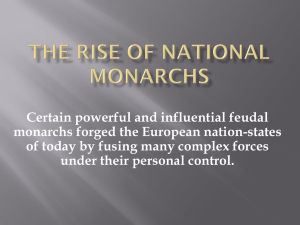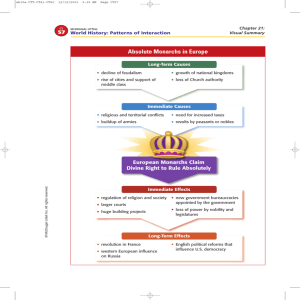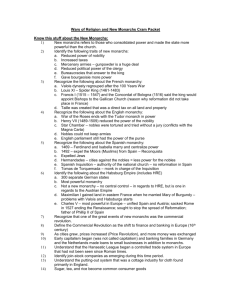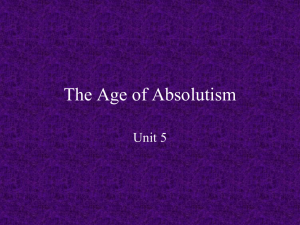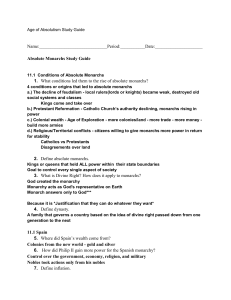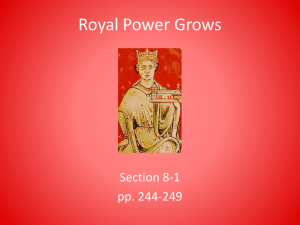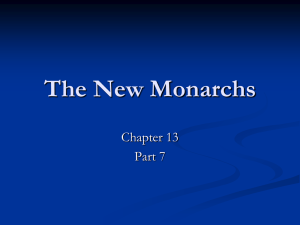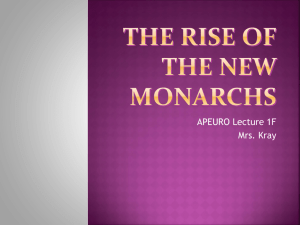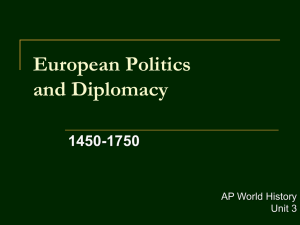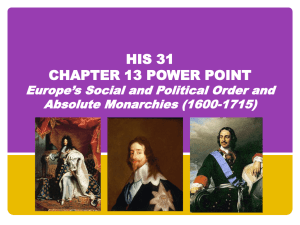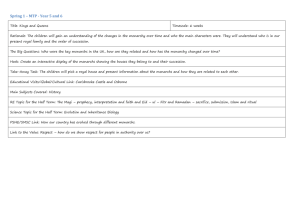New Monarchies
advertisement
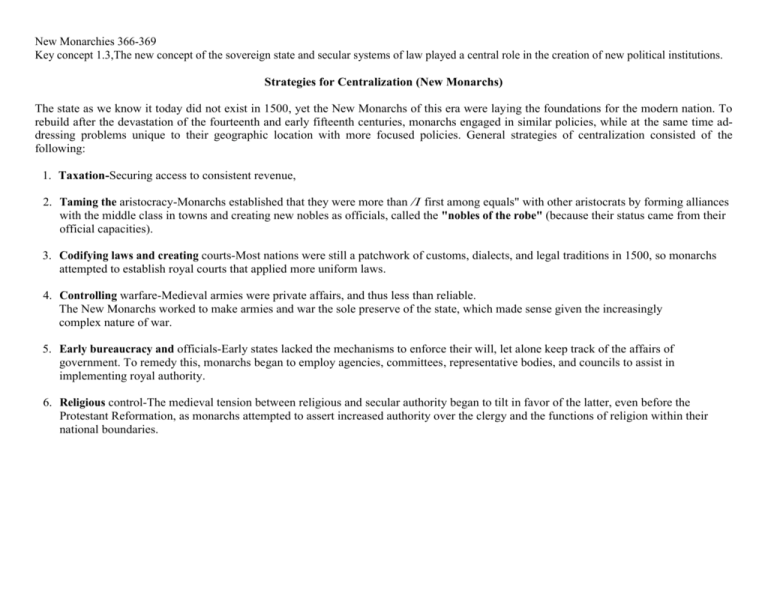
New Monarchies 366-369 Key concept 1.3,The new concept of the sovereign state and secular systems of law played a central role in the creation of new political institutions. Strategies for Centralization (New Monarchs) The state as we know it today did not exist in 1500, yet the New Monarchs of this era were laying the foundations for the modern nation. To rebuild after the devastation of the fourteenth and early fifteenth centuries, monarchs engaged in similar policies, while at the same time addressing problems unique to their geographic location with more focused policies. General strategies of centralization consisted of the following: 1. Taxation-Securing access to consistent revenue, 2. Taming the aristocracy-Monarchs established that they were more than /I first among equals" with other aristocrats by forming alliances with the middle class in towns and creating new nobles as officials, called the "nobles of the robe" (because their status came from their official capacities). 3. Codifying laws and creating courts-Most nations were still a patchwork of customs, dialects, and legal traditions in 1500, so monarchs attempted to establish royal courts that applied more uniform laws. 4. Controlling warfare-Medieval armies were private affairs, and thus less than reliable. The New Monarchs worked to make armies and war the sole preserve of the state, which made sense given the increasingly complex nature of war. 5. Early bureaucracy and officials-Early states lacked the mechanisms to enforce their will, let alone keep track of the affairs of government. To remedy this, monarchs began to employ agencies, committees, representative bodies, and councils to assist in implementing royal authority. 6. Religious control-The medieval tension between religious and secular authority began to tilt in favor of the latter, even before the Protestant Reformation, as monarchs attempted to assert increased authority over the clergy and the functions of religion within their national boundaries. Context: New Monarchies laid the foundation for the centralized modern state by establishing a monopoly on tax collection , military force, and dispensing of justice, and gaining the right to determine the religion of their subjects. Nation England Spain Challenges Following the Hundred Years’ War, England was plunged into the War of the Roses, a civil conflict between two factions of nobles. When the war ended in 1485, the Tudors set about rebuilding the power of the state Spain did not even exist until the marriage of Ferdinand and Isabella in 1469, and even then, Spain needed to complete the reconquista of the Moors and establish a national identity among its diverse kingdoms. Response Henry VII (1485 – 1509) and Henry VIII (1509 – 47) tamed the nobles, reducing the number of dukes from 9 to 2, and created a new aristocracy. Star Chamber – royal system of courts established. Ended livery and maintenance, the private armies of the nobles. Built England’s first state navy. Henry VIII took control of the Catholic Church in England and confiscated its lands. Isabella of Castile’s (1479 – 1504) and Ferdinand of Aragon’s (1479 – 1516) marriage did not create a unified nation. Made alliances with towns (hermandades) to establish law and order. Personally visited each area of the country Completed reconquista. Established strict religious orthodoxy with Spanish Inquisition from 1478 and expelled Jews in 1492 Sponsored voyages of exploration Charles I (aka Charles V in the HRE 1516 – 1555) inherited diverse lands and become the most powerful monarch in Europe Result The Tudors established the basis of English political and commercial power. However, Henry VIII’s obsession with producing a male heir demonstrated the continuing fragility of royal rule and also created a religious issue that would not be easily resolved. Spain emerged as the strongest nation in Europe. Access to the wealth of the New World and Charles inheritance of numerous lands established Spain’s golden Age. However, its crusading mindset, heavy taxes, and persecution talented minorities had already sapped some of its strength by the end of Charles rule. 1. Highlight or underline using different colors the differing themes of centralization England and Spain used in their movement to centralize. Holy Roman Empire Differs 1. Page 323 – Remind yourself – Describe the distribution of political power in Europe in the late Middle Ages. Specifically why wasn’t the German Monarchy able to centralize its authority? 2. Page 389 – Why wasn’t Maximilian able to institute any of the themes of centralization? 3. Page 389 – What was the success of the Holy Roman Empire? Compare and Contrast: In what ways was the development of monarchy in the Holy Roman Empire similar to AND different from the development of monarchy in other European countries.
